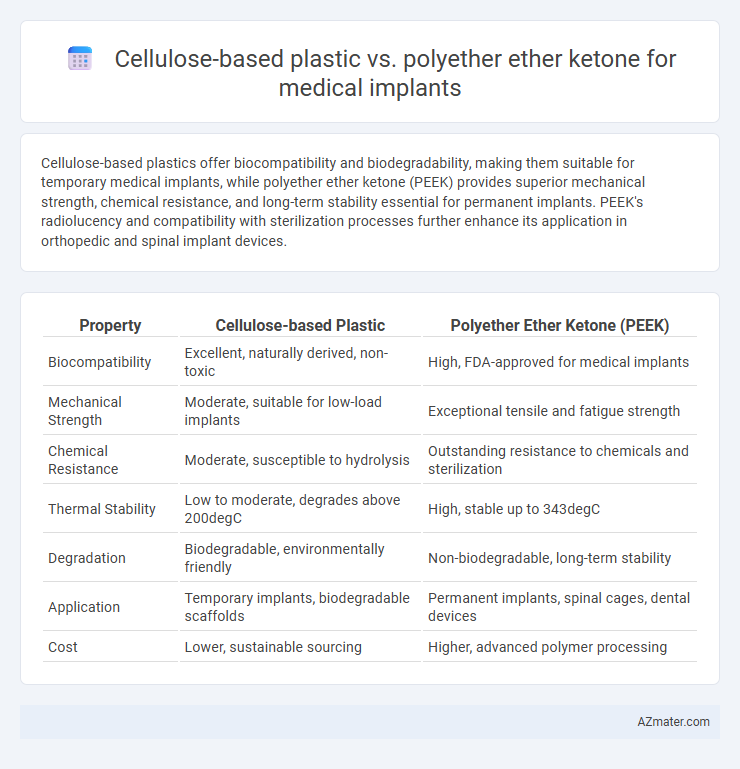Cellulose-based plastics offer biocompatibility and biodegradability, making them suitable for temporary medical implants, while polyether ether ketone (PEEK) provides superior mechanical strength, chemical resistance, and long-term stability essential for permanent implants. PEEK's radiolucency and compatibility with sterilization processes further enhance its application in orthopedic and spinal implant devices.
Table of Comparison
| Property | Cellulose-based Plastic | Polyether Ether Ketone (PEEK) |
|---|---|---|
| Biocompatibility | Excellent, naturally derived, non-toxic | High, FDA-approved for medical implants |
| Mechanical Strength | Moderate, suitable for low-load implants | Exceptional tensile and fatigue strength |
| Chemical Resistance | Moderate, susceptible to hydrolysis | Outstanding resistance to chemicals and sterilization |
| Thermal Stability | Low to moderate, degrades above 200degC | High, stable up to 343degC |
| Degradation | Biodegradable, environmentally friendly | Non-biodegradable, long-term stability |
| Application | Temporary implants, biodegradable scaffolds | Permanent implants, spinal cages, dental devices |
| Cost | Lower, sustainable sourcing | Higher, advanced polymer processing |
Introduction to Medical Implant Materials
Medical implant materials require biocompatibility, mechanical strength, and durability, with cellulose-based plastics offering biodegradability and natural origin benefits. Polyether ether ketone (PEEK) is a high-performance thermoplastic known for outstanding chemical resistance, mechanical stability, and radiolucency, making it suitable for long-term implants. Comparing cellulose-based plastics and PEEK highlights cellulose's eco-friendly profile versus PEEK's superior structural integrity and proven clinical success in orthopedic and dental applications.
Overview of Cellulose-Based Plastics
Cellulose-based plastics are derived from natural polymers found in plant cell walls, offering biocompatibility and biodegradability ideal for medical implant applications. Their structural properties can be tailored through chemical modifications to enhance mechanical strength and bioactivity, making them suitable for temporary implants and tissue engineering scaffolds. Compared to synthetic materials like polyether ether ketone (PEEK), cellulose-based plastics provide environmentally friendly alternatives with potential for reduced inflammation and improved integration with biological tissues.
Introduction to Polyether Ether Ketone (PEEK)
Polyether ether ketone (PEEK) is a high-performance thermoplastic polymer widely used in medical implants due to its excellent biocompatibility, chemical resistance, and mechanical strength. This semicrystalline material offers superior fatigue resistance and radiolucency, making it ideal for orthopedic and spinal implant applications. Compared to cellulose-based plastics, PEEK provides enhanced durability and stability in the human body, ensuring long-term implant functionality.
Biocompatibility: Cellulose-Based Plastics vs PEEK
Cellulose-based plastics exhibit excellent biocompatibility due to their natural origin and biodegradability, making them favorable for temporary medical implants that require minimal inflammatory response. Polyether ether ketone (PEEK) demonstrates superior mechanical strength and long-term stability while maintaining biocompatibility, suitable for permanent implants with resistance to wear and sterilization processes. Both materials support cell adhesion and proliferation, but PEEK's proven inertness and low cytotoxicity position it as the preferred choice for load-bearing orthopedic and spinal implants.
Mechanical Properties Comparison
Cellulose-based plastics exhibit moderate tensile strength and flexibility, making them suitable for temporary medical implants that require biodegradability. Polyether ether ketone (PEEK) demonstrates superior mechanical properties including high tensile strength (approximately 90-100 MPa), excellent fatigue resistance, and thermal stability, which are critical for long-term load-bearing implants. The mechanical robustness and chemical resistance of PEEK significantly surpass those of cellulose-based plastics, positioning PEEK as the preferred material for durable, implantable medical devices.
Sterilization and Chemical Resistance
Cellulose-based plastics exhibit moderate chemical resistance but can degrade under aggressive sterilization methods such as autoclaving or gamma irradiation, limiting their use in demanding medical implant environments. Polyether ether ketone (PEEK) demonstrates exceptional chemical resistance and withstands various sterilization processes, including steam, ethylene oxide, and gamma radiation, maintaining mechanical integrity and biocompatibility. The superior thermal stability and inertness of PEEK make it a preferred choice over cellulose-based plastics for implants requiring repeated sterilization and prolonged chemical exposure.
Degradation and Longevity in Medical Environments
Cellulose-based plastics exhibit biodegradability and tend to degrade in the human body over weeks to months, which limits their longevity for long-term medical implants. Polyether ether ketone (PEEK) displays exceptional chemical resistance and mechanical stability, maintaining integrity for many years without significant degradation in medical environments. The superior durability and bioinert nature of PEEK make it an ideal choice for implants requiring extended functional lifespan compared to cellulose-based plastics.
Cost-Effectiveness and Manufacturing Challenges
Cellulose-based plastics offer a low-cost, biodegradable alternative for medical implants but face challenges in achieving consistent mechanical strength and sterilization resistance. Polyether ether ketone (PEEK) provides superior durability, biocompatibility, and resistance to high temperatures, yet its high material cost and complex machining requirements increase overall manufacturing expenses. Balancing cost-effectiveness and performance, cellulose-based plastics suit disposable or short-term implants, while PEEK is preferred for long-term, high-stress applications due to its reliability and regulatory compliance.
Environmental Impact and Sustainability
Cellulose-based plastics for medical implants offer a renewable, biodegradable alternative to traditional materials, significantly reducing long-term environmental waste and carbon footprint. Polyether ether ketone (PEEK), while highly durable and biocompatible, relies on fossil-fuel-derived polymers, leading to higher environmental impact due to non-biodegradability and energy-intensive production processes. The sustainable profile of cellulose-based implants supports circular economy principles, making them preferable for eco-conscious medical applications.
Future Trends in Medical Implant Materials
Cellulose-based plastics offer biocompatibility and biodegradability, making them promising for temporary medical implants with reduced environmental impact. Polyether ether ketone (PEEK) provides superior mechanical strength and chemical resistance, ideal for load-bearing, long-term implants such as spinal and orthopedic devices. Future trends emphasize hybrid materials combining cellulose's sustainable properties with PEEK's durability, alongside advancements in 3D printing and bioactive surface modifications to enhance implant integration and patient outcomes.

Infographic: Cellulose-based plastic vs Polyether ether ketone for Medical implant
 azmater.com
azmater.com